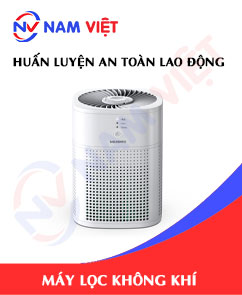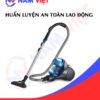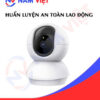Occupational Safety Training in Air Purifier Manufacturing
99,000 ₫
Note: The above price is calculated for one person, the price may fluctuate depending on the number of trainees participating in the course and depending on market movements. For more accurate pricing support, please refer to the quotation table or contact our consulting staff directly.
Occupational safety is an important issue in air purifier manufacturing factories and needs to be addressed promptly to ensure the health and safety of workers, and to enhance the reputation of businesses. The Occupational safety training course is one of the effective solutions to raise awareness about accident prevention for workers participating in air purifier manufacturing.
Table of Contents
Toggle1. Overview of Air Purifiers
a. What is an Air Purifier?
An air purifier is a device used to clean indoor air by removing dust particles, bacteria, viruses, odors, cigarette smoke, chemicals, and other allergens. Air purifiers work by drawing air through filters and releasing clean air.
Air purifiers are commonly used in enclosed spaces such as living rooms, bedrooms, or offices to reduce health hazards and improve air quality.

b. Machinery Used in Air Purifier Manufacturing
The manufacturing and assembly process of air purifiers involves the following main types of machinery:
- Metal cutting machines: used to cut metal materials into molds and smaller components for air purifier assembly.
- Metal bending machines: used to bend metal parts into shapes and sizes suitable for design requirements.
- Plastic injection machines: used to mold plastic parts for assembling air purifiers.
- Welding machines: used to weld metal and plastic parts together to form the frames of air purifiers.
- Foam cutting machines: used to cut foam into appropriate sizes for packaging into air purifiers.
- Assembly machines: used to assemble small parts together to complete the final product.
These machines are typically used in factories producing air purifiers to ensure high-quality products that are safe and effective for users.

c. Air Purifier Manufacturers in Vietnam
Currently, there are several well-known air purifier brands in Vietnam, including:
- Sharp: A famous electronics and home appliance brand, also producing air purifiers with features such as HEPA filtration, deodorization, dehumidification, antibacterial functions, energy saving, and ease of use.
- Panasonic: Specializes in electronic devices, including air purifiers, often equipped with HEPA filters, deodorization, antibacterial functions, and easy maintenance.
- Daikin: A leading air conditioning company that also produces air purifiers with advanced features like HEPA filtration, deodorization, antibacterial functions, dehumidification, and negative ion generation.
- Coway: Established in Vietnam since the 2000s, offering products like water purifiers, air purifiers, and alkaline water generators. Coway air purifiers include HEPA filters, deodorization, antibacterial features, negative ion generation, energy efficiency, and multiple fan speeds.
- Midea: A Chinese home appliance brand with affordable prices and good performance. Midea air purifiers usually include HEPA filtration, deodorization, antibacterial functions, and negative ion generation.
d. Specific Jobs in Air Purifier Manufacturing Plants
Group 1
- CEO, Deputy CEO, and department heads in air purifier manufacturing plants.
Group 2
- Safety officers: manage workplace safety, design safety procedures, monitor and enforce employee compliance with safety protocols.
Group 3
- Component production: manufacturing parts such as HEPA filters, activated carbon filters, fans, and control panels with precise processes.
- Assembly: assembling components into air purifiers following strict standards and procedures to ensure product quality.
- Quality control: thoroughly inspecting air purifiers to ensure product standards are met.
- Packing and shipping: after quality checks, products are packed and prepared for delivery to retailers or end customers.
Group 4
- Office work, support services, sales, and marketing.
- Production management, quality management, human resource management, material management, finance and accounting management.
- Product design: engineers design the functionality and features of air purifiers and select appropriate materials for production.

2. Overview of Occupational Safety Training for Air Purifier Manufacturing
This article focuses on issues related to Group 3, as they are directly involved in production and face the highest occupational safety risks. Learn more about other groups here.
a. What is Group 3 Occupational Safety Training?
- Group 3 occupational safety training consists of sessions that equip workers with awareness and skills to prevent workplace accidents.
- This training helps workers recognize and avoid hazards, minimizing the risks of accidents during work.
REGISTER FOR OCCUPATIONAL SAFETY TRAINING SERVICE
b. Training Duration
Initial Safety Training
- Total training time is at least 24 hours, including examination time.
- 8 hours of theoretical lessons on safety policies and labor hygiene laws
- 8 hours of theoretical lessons on basic occupational safety and hygiene knowledge
- 4 hours of theoretical lessons on specialized training content
- 2 hours of practical lessons on specialized training content
- 2 hours for the final theoretical examination
The safety training center schedules sessions based on worker availability. Typically, there are six sessions over three days, provided the manufacturer can allocate continuous training time.
Periodic Safety Training
- Before the occupational safety card expires, workers must complete periodic occupational safety training, with training duration being at least 50% of the initial training duration.
Explanation: The total periodic occupational safety training lasts at least 12 hours, including examination time. Upon completing the periodic training and passing the exam, workers will have their safety card renewed.
c. Training Content
| No. | TRAINING CONTENT | TRAINING TIME (HOURS) | |||
| Total | Including | ||||
| Theory | Practice | Exam | |||
| I | Safety policies and labor hygiene laws | 8 | 8 | 0 | 0 |
| 1 | Overview of legal documents on occupational safety and hygiene. | 6 | 6 | ||
| 2 | Standards and technical regulations on occupational safety and hygiene. | 1 | 1 | ||
| 3 | Specific regulations by government agencies for new construction, expansion, or renovation of facilities, equipment, and materials requiring strict occupational safety and hygiene compliance. | 1 | 1 | ||
| II | Basic knowledge of occupational safety and hygiene | 8 | 8 | 0 | 0 |
| 1 | Basic knowledge of hazards and harmful factors in the workplace. | 4 | 4 | ||
| 2 | Methods to improve working conditions. | 1 | 1 | ||
| 3 | Safety culture in production and business. | 1 | 1 | ||
| 4 | Rights and obligations of employers and employees; policies on occupational safety and hygiene; roles and responsibilities of safety officers. | 1 | 1 | ||
| 5 | Safety rules, signage, use of protective equipment and personal protective gear; first aid and occupational disease prevention skills. | 1 | 1 | ||
| III | Specialized training content | 6 | 4 | 2 | 0 |
| Comprehensive knowledge of machines, equipment, and hazardous substances; risk analysis and management; safe working procedures with equipment and materials requiring strict safety and hygiene compliance. | 6 | 4 | 2 | ||
| IV | Final occupational safety examination | 2 | 2 | 0 | 0 |
| Total | 24 | 22 | 2 | ||
See more training content of all 6 groups
d. Occupational Safety Card
After completing the occupational safety training and passing the exam, workers will be issued an occupational safety card (commonly called the Group 3 safety certificate).
The Group 3 safety card displays the worker’s full name, date of birth, job position, and work environment. It also shows training duration, an official stamp, and a signature confirming course completion.
According to regulations in Clause 2, Article 24 of Decree 44/2016/ND-CP, there are two cases:
- If the employer and employee have a labor contract, the employer must sign, stamp, and validate the safety card for Group 3 workers after completing training from a certified safety training provider and passing the exam.
- If the worker is freelance or temporary without a labor contract, the training provider must sign, stamp, and validate the safety card after the worker completes training and passes the exam.

3. Identifying Hazards Affecting Workers in Air Purifier Production
During the production of air purifiers, workers may be affected by the following hazards:
- Impact of chemicals: Chemicals used in air purifier production such as cleaning agents, detergents, fillers, surface coating chemicals, and coloring agents may have harmful effects on workers’ health, such as eye and respiratory irritation, skin damage, or poisoning if directly contacted or inhaled.
- Occupational accident risks: Equipment and machinery used in air purifier production, such as cutting machines, lathes, grinders, and welding machines, may cause workplace accidents if not operated properly and if workers do not follow safety procedures.
- Noise exposure: Certain stages of air purifier production, such as cutting or milling, may generate high and prolonged noise, affecting workers’ hearing.
- Electrical hazards: If electrical equipment in the factory is not regularly maintained, properly insulated, and waterproofed, it can pose a risk of electric shock to workers during production.
- Exposure to dust and fine particles: Dust and fine particles may be generated and suspended in the air during production, affecting workers’ respiratory health when inhaled.
- Exposure to UV rays and ozone: Processes using UV and ozone for air purification may affect workers’ health if not properly handled.
4. Common Workplace Accidents for Workers in Air Purifier Production
Common workplace accidents during air purifier production may include:
- Collision accidents: During transportation and handling of air purifier components, collisions with hard objects or other workers may occur, resulting in injuries such as head trauma, broken bones, or cuts.
- Cutting and puncture accidents: During metal cutting, processing, or assembly, sharp tools such as knives, scissors, or drill bits may be used. Without protective equipment, workers may injure themselves or others.
- Spray and splash accidents: Liquids, chemicals, or other objects may splash onto workers during machinery operation, causing injuries, burns, or health risks.
- Electrical accidents: Electrical devices used in air purifier production may pose life-threatening hazards if not handled correctly.
- Chemical accidents: Toxic chemicals used in air purifier production may harm workers if safety measures are not properly applied.

5. Safety Measures When Participating in Air Purifier Production
To ensure worker safety during air purifier production, the following measures can be applied:
- Ensure safety equipment and devices: Machinery and equipment should be regularly inspected to ensure proper and safe operation. Workers must be fully equipped with protective gear such as safety glasses, masks, gloves, helmets, safety shoes, and protective uniforms.
- Occupational safety training: Workers should be trained and guided on safety procedures and regulations in the factory, especially on using protective equipment and handling hazardous materials.
- Labor productivity control: Machinery and equipment must be operated within safe limits. Workers should be monitored to ensure they are not fatigued and remain focused on tasks.
- Work environment control: The factory environment must be controlled to ensure no harmful substances and that noise and dust levels are not excessive.
- Product quality control: Products must be checked to ensure they meet safety and efficiency standards.
- Risk assessment and management: Safety and health risks must be evaluated and managed to ensure a safe working environment.
- Preventive and emergency measures: The factory should have plans and solutions to prevent and respond to safety and health incidents.
- Regular workplace environment monitoring in the factory to collect and analyze harmful factors, adjust to reduce hazards, and prevent occupational diseases.
6. Benefits of Occupational Safety Training for Air Purifier Production
An Toan Nam Viet provides the following benefits to businesses after completing occupational safety training courses under Decree 44/2016/ND-CP on occupational safety and hygiene:
- Workers can identify potential accident hazards and take preventive measures to avoid workplace accidents.
- Businesses can establish risk prevention measures in production, operation, and maintenance processes.
- Minimize costs associated with workplace safety risks.
- Continuous production increases labor productivity and product quality.
- Compliance with occupational safety laws reduces legal risks.
- Enhances professionalism and company reputation, elevating the business brand.
Nam Viet’s training courses help individuals prevent external hazards that may lead to injuries or even death.
REGISTER FOR OCCUPATIONAL SAFETY TRAINING
7. Customer Feedback After Completing Occupational Safety Training for Air Purifier Production
An Toan Nam Viet has many years of experience accompanying enterprises in Vietnam in general, and in southern provinces in particular. This responsibility is extremely valuable for Nam Viet, which is why our occupational safety training is increasingly professional. The motivation for Nam Viet’s growth comes from positive feedback and suggestions from enterprises. Below are some feedback from our partners:
Bac Nam E&C Investment and Construction Joint Stock Company
“My first experience using An Toan Nam Viet’s services surprised me with the 24/7 enthusiastic support from the consulting team. Class organization was quick and convenient for our company. Thank you very much for Nam Viet’s service!”
Hoa Dat Construction and Trading Joint Stock Company
“Nam Viet’s services greatly helped us simplify occupational safety and complete safety documentation for the work process. The consulting team was enthusiastic and timely in addressing our questions. 5 stars for Nam Viet.”
See more customer interviews after using the services of An Toan Nam Viet
8. An Toan Nam Viet’s Capacity in Occupational Safety Training
An Toan Nam Viet is a reputable and high-quality occupational safety training center in Vietnam. Our safety training sessions are continuously conducted at production workshops, factories, and construction sites across the country (all 63 provinces of Vietnam).
REGISTER FOR OCCUPATIONAL SAFETY TRAINING
Occupational Safety Training License
- An Toan Nam Viet has been inspected and certified by the Department of Safety under the Ministry of Labor, War Invalids and Social Affairs and granted a certificate of eligibility for occupational safety and hygiene training. This further strengthens our capacity in occupational safety training.

Documents and Lectures
- Before being included in occupational safety training courses, all materials are reviewed to ensure the lectures are accurate and effective.
- Instructors’ teaching methods follow An Toan Nam Viet standards, developed by experts in occupational safety and hygiene training to ensure optimal knowledge absorption by learners.
Facilities
- Controlling classroom factors affecting training enhances teaching efficiency and knowledge retention.
- Our training facilities provide spacious classrooms meeting standards for area, lighting, and training equipment.
9. Nationwide Reputable and High-Quality Safety Training Center
At An Toan Nam Viet, we always prioritize professional dedication in occupational safety training. For us, imparting knowledge on self-protection to workers so they can stay safe while pursuing their livelihoods contributes to national development.
To ensure effective training, we carefully and meticulously prepare every detail, from tools, teaching equipment, curricula, materials, to sound and lighting.
Our occupational safety instructors are experts with many years of experience. They even conduct research on hazard identification across industries and methods to prevent them.
Lectures are based on practical experience and delivered in a vivid, easy-to-understand manner for workers. These factors make learning comfortable and ensure effective knowledge acquisition. All content strictly follows Decree 44/2016/ND-CP.
As a result, workers learn various hazard prevention measures and self-protection techniques, and how to apply them appropriately in real work situations.
Our safety training center is proud to provide professional and reputable occupational safety training services with the following advantages:
- Competitive training costs without compromising quality.
- Flexible training schedules to match company production needs.
- Quick and compliant certification procedures according to the law.
- Instructors with extensive professional experience.
- Classrooms controlled for factors affecting training to maximize teaching efficiency and learners’ knowledge retention.
- Course materials tailored to occupational safety needs in enterprises.
- An Toan Nam Viet works diligently and professionally to provide fast and precise support for customers.

10. Additional References for Occupational Safety Training in Air Purifier Production
- Occupational Safety Materials for Air Purifier Production
- Complete Set of Occupational Safety Training Materials
- Occupational Safety Training Test Set
- Occupational Safety Training Curriculum for Air Purifier Production
- Multiple Choice Test for Occupational Safety in Air Purifier Production
1 review for Occupational Safety Training in Air Purifier Manufacturing
No comments yet















namchinh.haiphong341
Đơn vị an toàn lao động uy tín tại Việt Nam nhé!